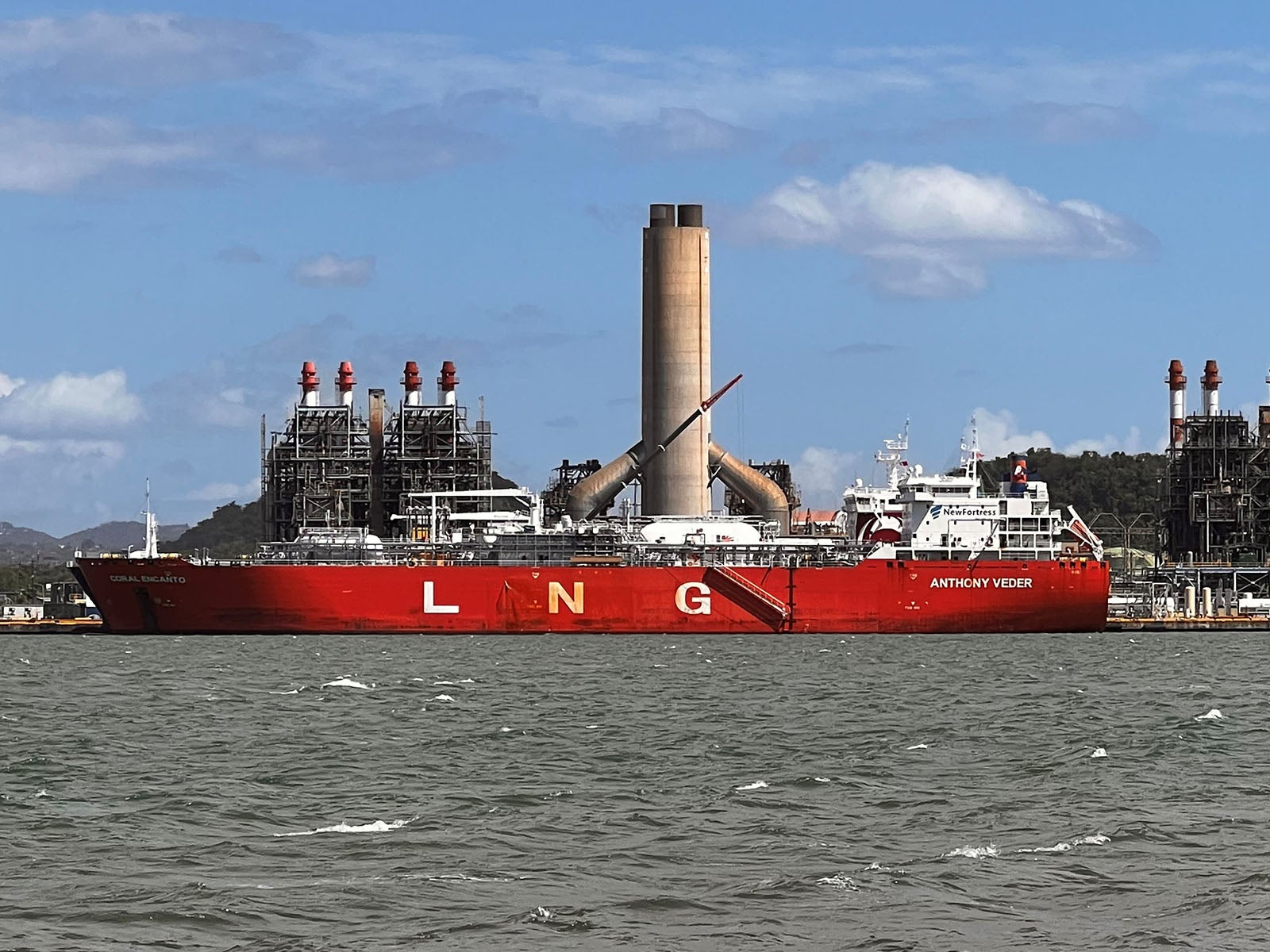San Juan communities demand oversight over rogue New Fortress Energy gas operation
San Juan Bay serves as the seaside gateway into Puerto Rico, with roughly 80 percent of the archipelago’s population concentrated in the metro area that rings its blue waters. Ships seeking its harbor and docks navigate a narrow inlet, passing the postcard forts and cruise ships of Old San Juan, La Fortaleza where the governor officially resides, and numerous communities that line the bay. Now one of the busiest ports in the Caribbean, the commerce centralized around the bay profoundly affects local communities neighboring the port’s industrial facilities.
One corner of the harbor is home to several low-income environmental justice communities that have long been plagued by pollution from the nearby petroleum terminal and port traffic. In March 2019, U.S.-based fossil fuel company New Fortress Energy began constructing a new liquefied natural gas (LNG) import terminal with the associated gas processing infrastructure and pipeline to the nearby San Juan power plant. No one in the surrounding communities, including Sabana, Vietnam, Amelia, Puerto Nuevo, or Cataño, had been notified or consulted about this project – even though the potentially explosive terminal sits less than a quarter mile from the closest homes. It soon became apparent that New Fortress Energy hadn’t gone through the proper permitting process to construct a LNG terminal required by the Federal Energy Regulatory Commission (FERC) either.
After several community organizations penned a letter demanding that FERC take jurisdiction over this illegally constructed and operated terminal, FERC opened an investigation. Earthjustice represented numerous local organizations and worked with the local utility’s own labor union to explain to FERC why it must take jurisdiction over this unaffordable, unreliable terminal. When the Commission ultimately agreed, New Fortress appealed FERC’s order finding jurisdiction over the terminal to the D.C. Circuit Court of Appeals. On behalf of our same clients and partners, Earthjustice filed an amicus brief arguing that the Natural Gas Act requires that terminals like this one undergo meaningful community and environmental review.
For too long, New Fortress has put local community members in harm’s way. Members of the Barrio Sabana neighborhood reside across a small inlet opposite the gas terminal, with some homes less than half a football field away. The people living in close proximity to the LNG terminal are within the blast radius of possible catastrophic gas explosions. They are also vulnerable to long-term health impacts from chronic exposure to increased toxic air pollution from methane leaks and added diesel exhaust from the terminal’s associated truck and ship traffic.
Reverend Dr. Sary N. Rosario Ferreira, a local pastor and member of the Faith Committee of El Puente Enlace Latino de Acción Climática, experienced the impacts from living in the Puerto Nuevo Norte neighborhood near the terminal:
“I had never suffered from asthma until I moved to Puerto Nuevo, in these eight years I have had asthma attacks, but in one in particular I almost did not live to tell about it. I was in the hospital, and I thank God who by his mercy gave me life. Air toxics are known or suspected to cause cancer and other serious health effects. So the claim that natural gas is better than other fossil fuels for adverse health effects has not been our experience. New Fortress started operations almost two years ago and my asthma condition has not improved but has continued. In fact, I had to move out of the area, but there are many people who live very close to New Fortress and the pollution that is generated in this operation. My Puerto Rican and Dominican neighbors deserve clean air for their lungs and for quality of life. I am deeply concerned about the health of the community and how this operation has been orchestrated without consultation of the location and without the permission of the Federal Energy Regulatory Commission.”
Beyond the immediate safety concerns, Puerto Ricans overwhelmingly recognize and demand the need for a rapid transformation of the Puerto Rico electric system to distributed renewable energy, which is also expressly established in local legislation. New Fortress Energy’s new LNG import terminal undermines Puerto Rico’s progress in achieving a self-reliant renewable energy system that doesn’t rely on fossil fuel imports. Rooftop solar and storage is far less vulnerable to storms like Hurricane Maria, which left thousands in the dark for months after devastating Puerto Rico’s outdated, fossil-dependent energy grid.
Myrna Conty, a local community leader with Amigos del Río Guaynabo, spoke to the importance of solar for the island’s climate resiliency:
“Transforming Puerto Rico’s energy system to run off of natural gas perpetuates the burning of fossil fuels, increasing climate change, and moves us away from implementing renewable energy. In our country, we have sun practically 365 days a year. The price of natural gas is currently increasing. To make matters worse, gas will raise our electricity rates even more. We have the solution, and it is to install photovoltaic systems on roofs with batteries. With a solar system, we would be a more resilient country. We are at risk of more powerful hurricanes for six months of the year as a result of climate change.”
Today the D.C. Circuit Court of Appeals heard oral arguments from New Fortress in its appeal of FERC’s order finding that the LNG terminal is subject to its jurisdiction and that New Fortress must retroactively apply for and comply with a permit. We hope that the D.C. Circuit will uphold the ruling and impress the importance of consulting with surrounding communities and conducting rigorous environmental and safety analyses before charging forward with more dangerous and unneeded fossil projects.
Earthjustice’s Clean Energy Program uses the power of the law and the strength of partnership to accelerate the transition to 100% clean energy.
The Florida regional office wields the power of the law to protect our waterways and biodiversity, promote a just and reliable transition to clean energy, and defend communities disproportionately burdened by pollution.
